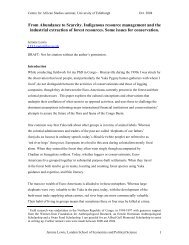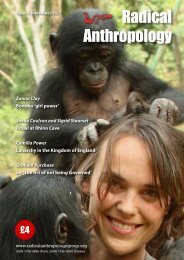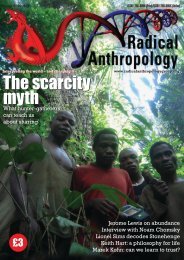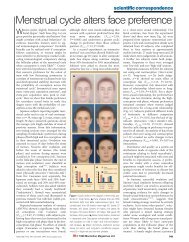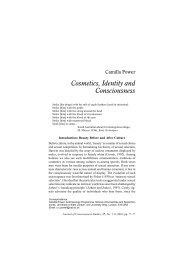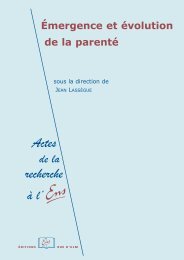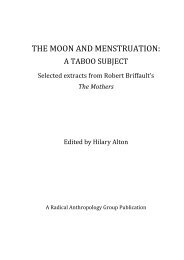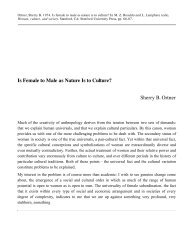Language and life history: A new perspective on the development ...
Language and life history: A new perspective on the development ...
Language and life history: A new perspective on the development ...
- No tags were found...
You also want an ePaper? Increase the reach of your titles
YUMPU automatically turns print PDFs into web optimized ePapers that Google loves.
References/Locke & Bogin: <str<strong>on</strong>g>Language</str<strong>on</strong>g> <str<strong>on</strong>g>and</str<strong>on</strong>g> <str<strong>on</strong>g>life</str<strong>on</strong>g> <str<strong>on</strong>g>history</str<strong>on</strong>g>Bishop, D. (1989) Autism, Asperger’s syndrome <str<strong>on</strong>g>and</str<strong>on</strong>g> semantic-pragmatic disorder:Where are <strong>the</strong> boundaries? British Journal of Disorders of Communicati<strong>on</strong>24:107–21. [aJLL]Bishop, D. V. M. (2001) Motor immaturity <str<strong>on</strong>g>and</str<strong>on</strong>g> specific speech <str<strong>on</strong>g>and</str<strong>on</strong>g> languageimpairment: Evidence for a comm<strong>on</strong> genetic basis. American Journal ofMedical Genetics (Neuropsychiatric Genetics) 114:56–63. [aJLL]Bishop, D. V. M., North, T. & D<strong>on</strong>lan, C. (1995) Genetic basis for specific languageimpairment: Evidence from a twin study. Developmental Medicine <str<strong>on</strong>g>and</str<strong>on</strong>g> ChildNeurology 37:56–71. [aJLL]Bishop, D. V. P. (2002) Motor immaturity <str<strong>on</strong>g>and</str<strong>on</strong>g> specific speech <str<strong>on</strong>g>and</str<strong>on</strong>g> languageimpairment: Evidence for a comm<strong>on</strong> genetic basis. American Journal ofMedical Genetics 114:56–63. [LW]Bjorklund, D. F. (1997) The role of immaturity in human <strong>development</strong>.Psychological Bulletin 122:153–69. [DFB, aJLL](2006) Mo<strong>the</strong>r knows best: Epigenetic inheritance, maternal effects, <str<strong>on</strong>g>and</str<strong>on</strong>g><strong>the</strong> evoluti<strong>on</strong> of human intelligence. Developmental Review26(2):213–42. [DFB]Bjorklund, D. F. & Pellegrini, A. D. (2002) The origins of human nature:Evoluti<strong>on</strong>ary <strong>development</strong>al psychology. American PsychologicalAssociati<strong>on</strong>. [aJLL]Björkqvist, K., Lagerspetz, K. M. J. & Kaukiainen, A. (1992a) Do girls manipulate<str<strong>on</strong>g>and</str<strong>on</strong>g> boys fight? Developmental trends regarding direct <str<strong>on</strong>g>and</str<strong>on</strong>g> indirect aggressi<strong>on</strong>.Aggressive Behavior 18:117–27. [aJLL]Björkqvist, K., Österman, K. & Kaukiainen, A. (1992b) The <strong>development</strong> of direct<str<strong>on</strong>g>and</str<strong>on</strong>g> indirect aggressive strategies in males <str<strong>on</strong>g>and</str<strong>on</strong>g> females. In: Of mice <str<strong>on</strong>g>and</str<strong>on</strong>g>women: Aspects of female aggressi<strong>on</strong>, ed. K. Björkqvist & P. Niemelä.Academic Press. [aJLL]Björkqvist, K., Österman, K. & Lagerspetz, K. M. J. (1994) Sex differences in covertaggressi<strong>on</strong> am<strong>on</strong>g adults. Aggressive Behaviour 20:27–33. [aJLL]Blacking, J. (1961) The social value of Venda riddling. African Studies20:1–32. [aJLL]Blank, D., Kumar, D., Meeden, L. & Marshal, J. (2005) Bringing up robot:Fundamental mechanisms for creating a self-motivated, self-organizingarchitecture. Cybernetics <str<strong>on</strong>g>and</str<strong>on</strong>g> Systems 36:125–50. [LJG]Blood, G. W. & Blood, I. M. (2004) Bullying in adolescents who stutter:Communicative competence <str<strong>on</strong>g>and</str<strong>on</strong>g> self-esteem. C<strong>on</strong>temporary Issues inCommunicative Sciences <str<strong>on</strong>g>and</str<strong>on</strong>g> Disorders 31:68–78. [aJLL]Bloom, K., D’Odorico, L. & Beaum<strong>on</strong>t, S. (1993) Adult preferences for syllabicvocalizati<strong>on</strong>s: Generalizati<strong>on</strong>s to parity <str<strong>on</strong>g>and</str<strong>on</strong>g> native language. Infant Behavior<str<strong>on</strong>g>and</str<strong>on</strong>g> Development 16:109–20. [aJLL]Blount, B. G. (1985) “Girney” vocalizati<strong>on</strong>s am<strong>on</strong>g Japanese Macaque females:C<strong>on</strong>text <str<strong>on</strong>g>and</str<strong>on</strong>g> functi<strong>on</strong>. Primates 26:424–35. [rJLL]Blurt<strong>on</strong> J<strong>on</strong>es, N. (1972) Comparative aspects of mo<strong>the</strong>r-child c<strong>on</strong>tact. In:Ethological studies in child behaviour, ed. N. Blurt<strong>on</strong> J<strong>on</strong>es. CambridgeUniversity Press. [aJLL]Blurt<strong>on</strong> J<strong>on</strong>es, N. G. (1993) The lives of hunter-ga<strong>the</strong>r children: Effects ofparental behavior <str<strong>on</strong>g>and</str<strong>on</strong>g> parental reproducti<strong>on</strong> strategy. In: Juvenile primates,ed. M. E. Pereira & L. A. Fairbanks, pp. 309–26. Oxford UniversityPress. [aJLL]Blurt<strong>on</strong> J<strong>on</strong>es, N. G., Smith, L. C., O’C<strong>on</strong>nel, J. F. & H<str<strong>on</strong>g>and</str<strong>on</strong>g>ler, J. S. (1992)Demography of <strong>the</strong> Hadza, an increasing <str<strong>on</strong>g>and</str<strong>on</strong>g> high density populati<strong>on</strong> ofsavanna foragers. American Journal of Physical Anthropology89:159–81. [aJLL]Boberg, J. M. & Boberg, E. (1990) The o<strong>the</strong>r side of <strong>the</strong> block: The stutterer’sspouse. Journal of Fluency Disorders 15:61–75. [aJLL]Bodamer, M. D. & Gardner, R. A. (2002) How cross-fostered chimpanzeesinitiate <str<strong>on</strong>g>and</str<strong>on</strong>g> maintain c<strong>on</strong>versati<strong>on</strong>s. Journal of Comparative Psychology116:12–26. [RAG]Bogin, B. (1988) Patterns of human growth. Cambridge UniversityPress. [arJLL, RBE](1990) The evoluti<strong>on</strong> of human childhood. BioScience 40:16–25. [aJLL](1997) Evoluti<strong>on</strong>ary hypo<strong>the</strong>ses for human childhood. Yearbook of PhysicalAnthropology 40:63–89. [arJLL](1999a) Evoluti<strong>on</strong>ary <str<strong>on</strong>g>perspective</str<strong>on</strong>g> <strong>on</strong> human growth. Annual Review ofAnthropology 28:109–53. [arJLL](1999b) Patterns of human growth, 2nd editi<strong>on</strong>. Cambridge UniversityPress. [arJLL, RBE](2001) The growth of humanity. Wiley-Liss. [arJLL](2003) The human pattern of growth <str<strong>on</strong>g>and</str<strong>on</strong>g> <strong>development</strong> in pale<strong>on</strong>tological<str<strong>on</strong>g>perspective</str<strong>on</strong>g>. In: Patterns of growth <str<strong>on</strong>g>and</str<strong>on</strong>g> <strong>development</strong> in <strong>the</strong> Genus Homo, ed.J. L. Thomps<strong>on</strong>, G. E. Krovitz & A. J. Nels<strong>on</strong>, pp. 15–44. CambridgeUniversity Press. [aJLL]Bogin, B. & Smith, B. H. (1996) Evoluti<strong>on</strong> of <strong>the</strong> human <str<strong>on</strong>g>life</str<strong>on</strong>g> cycle. AmericanJournal of Human Biology 8:703–16. [arJLL]Borchert, C. M. & Zihlman, A. L. (1990) The <strong>on</strong>togeny <str<strong>on</strong>g>and</str<strong>on</strong>g> phylogeny of symbolizing.In: The <str<strong>on</strong>g>life</str<strong>on</strong>g> of symbols, ed. M. L. Foster & L. J. Botscharow, pp. 15–44.Westview. [BJK]Botha, R. P. (2003) Unravelling <strong>the</strong> evoluti<strong>on</strong> of language. Elsevier. [aJLL]Bott, E. (1971) Family <str<strong>on</strong>g>and</str<strong>on</strong>g> social network: Roles, norms, <str<strong>on</strong>g>and</str<strong>on</strong>g> external relati<strong>on</strong>shipin ordinary urban families. Tavistock Publicati<strong>on</strong>s. [aJLL]Botting, N. & C<strong>on</strong>ti-Ramsden, G. (2000) Social <str<strong>on</strong>g>and</str<strong>on</strong>g> behavioural difficulties inchildren with language impairment. Child <str<strong>on</strong>g>Language</str<strong>on</strong>g> Teaching <str<strong>on</strong>g>and</str<strong>on</strong>g> Therapy16:105–20. [aJLL]Bott<strong>on</strong>i, L., Massa, R. & Lenti Boero, D. (2003) The Grey parrot (Psittacuserithacus) as musician: An experiment with <strong>the</strong> temperate scale. Ethology,Ecology <str<strong>on</strong>g>and</str<strong>on</strong>g> Evoluti<strong>on</strong> 15(2):133–41. [DLB]Bott<strong>on</strong>i, L., Masin, S., Lenti Boero, D. & Pioli, P. (2004) Teaching <strong>the</strong> musicalcode to a Grey parrot (Psittacus erithacus): Theoretical <str<strong>on</strong>g>and</str<strong>on</strong>g> experientialinsights. In: Abstracts of <strong>the</strong> Internati<strong>on</strong>al Symposium PME04, Padua, Italy.Psychology <str<strong>on</strong>g>and</str<strong>on</strong>g> Music Educati<strong>on</strong>: In Memoriam of Giuseppe Porzi<strong>on</strong>ato,ed. M. Biasutti, p. 79. CLEUP, The University Press of PadoaUniversity. [DLB]Brenneis, D. & Padarath, R. (1975) “About those scoundrels I’ll let every<strong>on</strong>e know”:Challenge singing in a Fiji Indian community. Journal of American Folklore88:283–91. [arJLL]Bright<strong>on</strong>, H., Kirby, S. & Smith, K. (2005a) Cultural selecti<strong>on</strong> for learnability:Three principles underlying <strong>the</strong> view that language adapts to be learnable.In: <str<strong>on</strong>g>Language</str<strong>on</strong>g> origins: Perspectives <strong>on</strong> evoluti<strong>on</strong>, ed. M. Tallerman,pp. 291–309. Oxford University Press. [HB]Bright<strong>on</strong>, H., Smith, K. & Kirby, S. (2005b) <str<strong>on</strong>g>Language</str<strong>on</strong>g> as an evoluti<strong>on</strong>ary system.Physics of Life Reviews 2:177–226. [HB]Briscoe, E. J., ed. (2002) Linguistic evoluti<strong>on</strong> through language acquisiti<strong>on</strong>: Formal<str<strong>on</strong>g>and</str<strong>on</strong>g> computati<strong>on</strong>al models. Cambridge University Press. [HB]Brockway, R. (2003) Evolving to be mentalists: The “mind-reading mums”hypo<strong>the</strong>sis. In: From mating to mentality: Evaluating evoluti<strong>on</strong>ary psychology,ed. K. Sterelny & J. Fitness. Psychology Press. [aJLL]Brody, S. (1945) Bioenergetics <str<strong>on</strong>g>and</str<strong>on</strong>g> growth. Reinhold. [aJLL]Brooks, P. J. (2004) Grammatical competence is not a psychologically validc<strong>on</strong>struct. Journal of Child <str<strong>on</strong>g>Language</str<strong>on</strong>g> 31:467–70. [SR]Brown, K. & Mack, D. S. (1978) Food sharing am<strong>on</strong>g captive Le<strong>on</strong>topi<strong>the</strong>cusrosalia. Folia Primatologica 29:268–90. [GEW]Bruner, J. (1978) Foreword. In: Acti<strong>on</strong> gesture <str<strong>on</strong>g>and</str<strong>on</strong>g> symbol: The emergence oflanguage, ed. A. Lock, pp. vii–viii. Academic Press. [RAG]Burbank, V. K. (1994) Fighting women: Anger <str<strong>on</strong>g>and</str<strong>on</strong>g> aggressi<strong>on</strong> in AboriginalAustralia. University of California Press. [aJLL]Burles<strong>on</strong>, B. R. (1982) The <strong>development</strong> of comforting communicati<strong>on</strong> skillsin childhood <str<strong>on</strong>g>and</str<strong>on</strong>g> adolescence. Child Development 53:1578–88. [aJLL]Burns, T. A. (1976) Riddling: Occasi<strong>on</strong> to act. Journal of American Folklore89:139–65. [rJLL]Burroughs, E. I. & Tomblin, J. B. (1990) Speech <str<strong>on</strong>g>and</str<strong>on</strong>g> language correlates ofadults’ judgments of children. Journal of Speech <str<strong>on</strong>g>and</str<strong>on</strong>g> Hearing Disorders55:485–94. [aJLL]Cabana, T., Jolicoeur, P. & Michaud, J. (1993) Prenatal <str<strong>on</strong>g>and</str<strong>on</strong>g> postnatal growth <str<strong>on</strong>g>and</str<strong>on</strong>g>allometry of stature, head circumference, <str<strong>on</strong>g>and</str<strong>on</strong>g> brain weight in Québecchildren. American Journal of Human Biology 5:93–99. [aJLL]Calvin, W. H. (1996) How brains think: Evolving intelligence. Basic Books. [SR](1998) The cerebral code: Thinking a thought in <strong>the</strong> mosaics of <strong>the</strong> mind.MIT Press. [SR]Campbell, A. (1999) Staying alive: Evoluti<strong>on</strong>, culture <str<strong>on</strong>g>and</str<strong>on</strong>g> women’s intrasexualaggressi<strong>on</strong>. Behavioral <str<strong>on</strong>g>and</str<strong>on</strong>g> Brain Sciences 22(2):203–14. [rJLL]Camperio Ciani, A. & Chiarelli, B. (1988) A systematic relati<strong>on</strong>ship between brainsize increase <str<strong>on</strong>g>and</str<strong>on</strong>g> larynx transformati<strong>on</strong> during hominizati<strong>on</strong>. In: <str<strong>on</strong>g>Language</str<strong>on</strong>g>origin: A multidisciplinary approach, ed. J. Wind, B. Chiarelli, B. Bichakjian,A. Nocentini & A. J<strong>on</strong>ker, pp. 51–66. (NATO ASI Series D: Behavioural <str<strong>on</strong>g>and</str<strong>on</strong>g>Social Sciences, 31). Kluwer Academic. [DLB]C<str<strong>on</strong>g>and</str<strong>on</strong>g>olin, U. (2003) The use of multiple cues in mate choice. Biological Review78:575–95. [rJLL]Cangelosi, A. & Parisi, D., eds. (2001) Simulating <strong>the</strong> evoluti<strong>on</strong> of language.Springer. [HB]Capp, B. (2003) When gossips meet: Women, family, <str<strong>on</strong>g>and</str<strong>on</strong>g> neighbourhood in earlymodern Engl<str<strong>on</strong>g>and</str<strong>on</strong>g>. Oxford University Press. [aJLL]Caro, T. M. & Hauser, M. D. (1992) Is <strong>the</strong>re teaching in n<strong>on</strong>human animals?Quarterly Review of Biology 67:151–74. [aJLL]Carroll, J. B. (1993) Human cognitive abilities: A survey of factor-analytic studies.Cambridge University Press. [aJLL]Carru<strong>the</strong>rs, P. (1996) <str<strong>on</strong>g>Language</str<strong>on</strong>g>, thought <str<strong>on</strong>g>and</str<strong>on</strong>g> c<strong>on</strong>sciousness. Cambridge UniversityPress. [SJC]Carstairs-McCarthy, A. (1999) The origin of complex language. Oxford UniversityPress. [aJLL](2004) Many <str<strong>on</strong>g>perspective</str<strong>on</strong>g>s, no c<strong>on</strong>sensus. Science 303:1299–300. [aJLL]Chalcraft, V. J. & Gardner, R. A. (2005) Cross-fostered chimpanzees modulate signsof American Sign <str<strong>on</strong>g>Language</str<strong>on</strong>g>. Gesture 5:107–31. [RAG]Chance, M. R. A. (1967) Attenti<strong>on</strong>-structure as <strong>the</strong> basis of primate rank orders.Man 2:503–18. [aJLL]Chance, M. R. A. & Jolly, C. J. (1970) Social groups of m<strong>on</strong>keys, apes <str<strong>on</strong>g>and</str<strong>on</strong>g> men.J<strong>on</strong>athan Cape. [aJLL]BEHAVIORAL AND BRAIN SCIENCES (2006) 29:3 313



